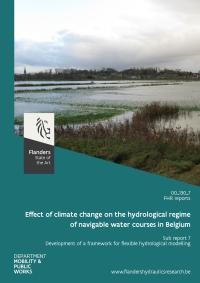Gedaan met laden. U bevindt zich op: Effect of climate change on the hydrological regime of navigable water courses in Belgium. Sub report 7. Development of a framework for flexible hydrological modelling
Effect of climate change on the hydrological regime of navigable water courses in Belgium. Sub report 7. Development of a framework for flexible hydrological modelling
The recent studies by Vansteenkiste et al. (2011, 2012a and 2012b) have shown that the potential hydrological impacts caused by climate change scenarios for Belgium have high uncertainty. For a given climate scenario, the quantitative impact results on the hydrological extremes and overall water balance strongly depend on the selected hydrological model. However, there is a wide variety of existing hydrological models which are now available with different levels of complexity. Therefore, it is necessary to analyze the model structure uncertainty affecting the impact results. An ensemble approach is recommended, where different plausible model structures are tested and inter-compared.
To make such approach feasible in an operational context, an innovative flexible framework is developed and proposed in this study. The framework starts from the multi-model / multi-process ensemble concept, which provides the ability to pinpoint the uncertainties related to hydrological modelling, including the selected model structure, in impact investigations such as climate change or land use change or other types of scenario investigations. This framework, moreover, contains some advantageous aspects, namely the data based approach, the flexibility in model components (hydrological processes) and equations, the spatial implementation, the flexibility in spatial resolution, the model calibration approach for various spatial scales and the flexibility for future extension.Several well-known lumped and distributed prevailing hydrological models and modelling systems (platforms) were reviewed and presented in order to define the most basic or common hydrological processes that should be implemented in the proposed concept. The popular approaches for presenting hydrological connectivity inside catchments are as well listed. Moreover, PCRaster in Python programming language with its great functionality for spatio-temporal environmental modelling was selected as the platform for the proposed framework. Three lumped models (i.e. NAM, PDM and VHM) were translated into Python language within the PCRaster environment. The converted scripts were then applied to the case study of the Grote Nete catchment, using the same inputs and model parameters as in the report of Vansteenkiste et al. (2012a). The performance of the translated scripts was evaluated by comparing the simulation results to those from the existing Matlab scripts. The comparisons done for the NAM, PDM and VHM lumped conceptual models have shown a perfect match, which indicates the potential for further implementation of the proposed concept in PCRaster. A distributed version of the NAM model was built and recalibrated for the same catchment to show the possibility for spatial implementation in PCRaster. A concrete work phase is made where the flexible modelling framework, including the flexible approaches for spatial calibration or disaggregation and hydrological spatial linking (explicit versus non-explicit), is implemented and applied for (climate change) impact analysis for a number of catchments.

Lees de publicatie
- Publicatiedatum
- Juni 2022
- Publicatietype
- Onderzoeksrapport
- Thema's
- Scheepvaart en havens
- Auteur(s)
- Q. Tran, P. Willems, F. Pereira, J. Nossent, F. Mostaert
- Reeks
- FHR reports 00_130_7